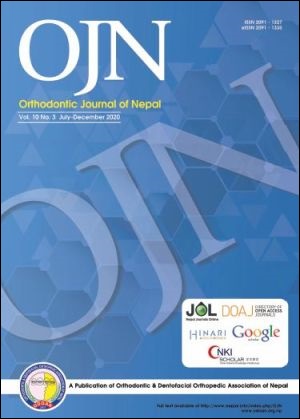Pattern of Malocclusion among Patients Seeking Orthodontic Treatment at Hospitals and Private Clinics of Province 2, Nepal
DOI:
https://doi.org/10.3126/ojn.v10i3.35491Keywords:
Angle's classification, Malocclusion, Occlusal traits, OrthodonticsAbstract
Introduction: Malocclusion affect the esthetic, function of the patients, so they seek orthodontic treatment for normal function and healthy and beautiful smile. Increase in public awareness and availability of orthodontic specialty services have led to increasing number of orthodontic patients in specialty clinics and hospitals. The objective of this study is to examine the pattern of malocclusion in the patients visiting medical and dental teaching hospitals and dental clinics and to measure the different Angle’s classification of malocclusion with discrepancies in all three planes.
Materials and Method: Three hundred seventeen acceptable study casts were selected from 403 case records of orthodontic patients who visited the different hospitals and private clinics of Province 2, Nepal. A standard guidance of Angle’s classification was used to classify the cases and casts were measured to record the data. Different Angle’s classification of malocclusion with discrepancies in all three planes was studied. Descriptive statistics (frequency, percentage, mean and SD) and inferential statistics (chi square and fisher exact test) was used to find out the association between occlusal traits and demographic variables.
Result: According to the Angle’s classification of malocclusion, most of the patient’s cast 65.9% were of class I, followed by class II 31.8%, class III 5.3% occlusion pattern. Among the class II malocclusion, class II division 1 malocclusion was more prevalent (86.13%). Under space discrepancies, crowding of teeth was present in 42.58% of patient. Of the total teeth crowding patient, 70.3% had crowding of teeth in both the arches followed by only mandibular arch (25.18%). There is statistically significant association between the age and the occlusal traits like crowding (p value 0.008), spacing (p value 0.000) and overjet (p value 0.000) at 0.01 level of significance.
Conclusion: Angle’s class I was the most prevalent malocclusion followed by class II and class III. Increased overjet was the commonest occlusal trait. There was statistically significant association between the age and occlusal traits like crowding, spacing and overjet.
Downloads
Downloads
Published
How to Cite
Issue
Section
License
Copyright © held by Orthodontic & Dentofacial Orthopedic Association of Nepal
- Copyright on any research article is transferred in full to the Orthodontic & Dentofacial Orthopedic Association of Nepal upon publication in the journal. The copyright transfer includes the right to reproduce and distribute the article in any form of reproduction (printing, electronic media or any other form).
- Articles in the Orthodontic Journal of Nepal are Open Access articles published under the Creative Commons CC BY License (https://creativecommons.org/licenses/by/4.0/)
- This license permits use, distribution and reproduction in any medium, provided the original work is properly cited.




